 Image search results - "ashi" Image search results - "ashi" |

Akashi StationOn the JR Sanyo Line.
|
|

Akashi Castle seen from the train platform of Akashi Station.
|
|

Ryogoku Kokugikan sumo arena as seen from Ryogoku Station
|
|

JR Kofu Station
|
|

Akashi Castle seen from the train platform of Akashi Station.
|
|

Crowd outside the Kokugikan await their favorite wrestlers.
|
|
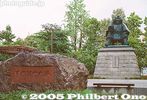
Park in front of Kofu Station.
|
|

Crowd enters the Kokugikan for Musashimaru's retirement ceremony on Oct. 2, 2004.
|
|

Statue of Takeda Shingen.
|
|

Castle moat
|
|

Passing out programs
|
|

Entrance to Akashi Park
|
|

Musashimaru at the entrance
|
|
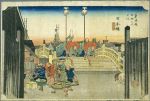
Hiroshige's woodblock print of Nihonbashi from his "Fifty-Three Stations of the Tokaido Road" series.
|
|

Castle moat
|
|

Musashimaru greets the crowd
|
|

Eisen's woodblock print of Nihonbashi from his Kisokaido series.
|
|

Twin turrets of Akashi Castle
|
|

Hawaii's last sumo wrestler shakes hands.If he were married, his wife would be beside him.
|
|

Chuo-dori avenue looking toward Nihonbashi Bridge.
|
|

Twin turrets of Akashi CastleThe left turret is called the Hitsujisaru Turret (坤櫓) and the right one is called the Tatsumi Turret (巽櫓).
|
|

Musashimaru right after I shook his hand.
|
|

Nihonbashi Bridge ahead, with the expressway over it.
|
|

Hitsujisaru Turret (坤櫓)
|
|

Signboard for retirement ceremony at entrance.It reads "Musashimaru, Intai Danpatsu Hiroo Ozumo" which means "Musashimaru Topknot-Cutting and Retirement Sumo Exhibition."
|
|

Omi Fair video taken on March 2, 2014 at Takashimaya Dept. Store in Nihonbashi, Tokyo. Funazushi, Omi beef, Biwa pearls, and more. We also saw Hiko-nyan.
|
|

Castle tower
|
|
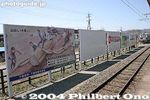
Billboard depicting Ki-otoshi (Log Drop) at Shimosuwa Station.
|
|
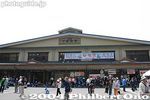
Shimosuwa Station on May 8, 2004. Here for the final three days of the Onbashira Matsuri's climax, the Satobiki when they haul the Onbashira logs to the Shimo-sha Shrines (Akimiya and Harumiya) and erect them.
|
|

The gateway to the Seta area is Karahashi-mae Station.
|
|

From the Ohmi Railways' Gokasho Station, you can walk to the Fujii Hikoshiro House (藤井 彦四郎邸), which is also a history museum, and to the modern Ohmi Merchant Museum (近江商人博物館).Ohmi Railways Gokasho Station 近江鉄道五箇所駅
|
|

Gokasho is famous for the grand, old homes of wealthy Omi merchants. Three of them are clustered together for us to visit inside. They are the former residences of Tonomura Uhee (外村 宇兵衛), Tonomura Shigeru (外村 繁), and Nakae Jungoro (中江
|
|
|
|

Way to Takashimaya Dept. Store in Nihonbashi subway station.
|
|

Path to turrets
|
|

Omatsuri is actually a place name. The small settlement has a lodge and restaurant.
|
|

Bus to Taba. The bus runs from Okutama Station in Tokyo. It is the only public transportation link with the village.
|
|

On June 16, 2007, Imazu marked the 90th anniversary of the song by organizing a boat cruise on Lake Biwa and other events. Omi-Imazu Station had a sign directing guests to Imazu Port. 90周年の記念「琵琶湖周航クルーズ」の近江今津駅内
|
|

During July-Aug. 2007, I helped to make the Yokaichi giant kite at the annex of the Yokaichi Giant Kite Museum.where the giant kite is made. Every three years, the giant kite, flown every May in Higashi-Omi, is replaced by a new kite bearing a new design.The new kite was made during July-Aug. 2007, taking about 30 days. The kite is made by volunteers from the public under the instruction of the Yokaichi Giant Kite Preservation Society. For the first time, I helped make this giant kite which was first flown successsfully on May 25, 2008 at the annual kite festival.
|
|

On July 29, 2007, this regatta was held for the second time. It targets mainly beginner rowers. Organized by the Seta Rowing Club which seeks to have more people enjoy water sports on Lake Biwa. Seta-Karahashi Bridge was the regatta's starting line. The Lake Biwa Rowing Song CD was awarded to all the 1st, 2nd, and 3rd place winners in all five categories.
|
|

Musashigawa stablemaster (former Yokozuna Mienoumi) in the entrance hallInside the entrance hallway, there was a long table on the left side with ribbons which served as name tags for distinguished guests. Musashigawa is the name of Musashimaru's sumo stable.
|
|
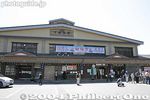
Shimosuwa Station 下諏訪駅
|
|

Onbashira monument in front of Shimosuwa Station. This Onbashira log was used in the opening ceremony of the Nagano Winter Olympics in 1998.
|
|

Keihan train at Karahashi-mae Station.
|
|

You can buy a set of tickets to all four Omi merchant homes and the museum which cheaper than buying a ticket at each place. Ohmi Railways Gokasho Station 近江鉄道五箇所駅
|
|

Gokasho was home to many Omi merchants who plied up and down Japan during the Edo Period to sell and trade their wares. They became quite successful selling medicines, lacquerware, sake, etc.Wall of former home of Omi merchant Tonomura Shigeru (1902-1961) (外村 繁邸).
|
|

The original Nihonbashi Bridge was built in 1603, out of wood.
|
|

Way to Takashimaya Dept. Store in Nihombashi subway station.
|
|

Steps to turrets
|
|

Omatsuri bus stop for Okutama.
|
|

I was in Okutama and noticed that the bus goes on to Tabayama village in neighboring Yamanashi. I got really curious and rode the bus to Tabayama. This is central Tabayama.
|
|

Imazu Port. A large crowd of people waiting to board the chartered boat for a 3-hour cruise on Lake Biwa to commemorate the 90th anniversary of the song, Biwako Shuko no Uta.
|
|

Entrance to the annex and a sign indicating the day's event or work. Today, July 7, 2007, was the Noritsuke Pasting Ceremony. 八日市大凧まつり のりつけ式
|
|

Sixty rowing teams (300 people) rowed in five categories, including beginner and expert rowers, ranging in age from junior high to senior citizens.
|
|

Model at Nikon booth
|
|

Entrance hall is clogged up by a side show of hula.
|
|
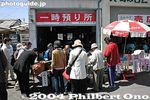
Store your luggage here. Not enough lockers at the train station so they provide this service. 400 yen/day.
|
|
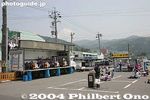
Entertainment stage in front of Shimosuwa Station.
|
|

Seta-no-Karahashi Bridge with the new paint job in 2012. 瀬田之唐橋
|
|
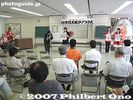
July 7, 2007: The making of the giant kite started with Noritsuke Pasting Ceremony where the new design was announced and dignitaries pasted together the first pieces of the kite paper.
|
|

Ohmi Railways Gokasho Station, waiting room.
|
|

Former home of Omi merchant Tonomura Shigeru (外村 繁邸). MapTonomura Shigeru (外村 繁), Tonomura Uhee (外村 宇兵衛), and Nakae Jungoro (中江 準五郎)
|
|

Nihonbashi Bridge and the ugly expressway above.
|
|
|

Tatsumi Turret (巽櫓)
|
|

Omatsuri bus stop for Taba.
|
|

When I walked around, my planned 20-min. stay turned into a 2-hour walking tour of this pacifying place, full of mountains and a clear river. A delightful discovery. Suigen Park
|
|

The "Rio Grande" cruise boat awaits at Imazu Port on a miraculously sunny day during the rainy season. 梅雨でありながら、奇跡的にこんないい天気になった。今津港
|
|

This is the boat dock where people got on and off the boats. The boats were provided by local rowing organizations. The regatta was organized by the Seta Rowing Club in Otsu.
|
|

Musashigawa Stable wrestlers greet visitorsIncludes Miyabiyama and Musoyama.
|
|
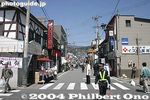
Go straight on this road in front of the station.
|
|
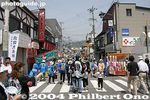
In front of Shimosuwa Station.
|
|

The original Seta-no-Karahashi Bride was the site of historic battles. It has two bridges, one long and one short going over an island in the river.
|
|

Ohmi Railways Gokasho Station building as seen from the train platform.
|
|
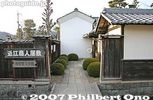
Entrance to former home of Omi merchant Tonomura Shigeru (外村 繁邸). Gokasho is also a National Important Traditional Townscape Preservation District (重要伝統的建造物群保存地区).
|
|

Nihonbashi Bridge today is the 19th reconstructed Nihonbashi Bridge since 1603. 日本橋
|
|

Takashimaya got its name from Takashima, Shiga Prefecture.
|
|

Tatsumi Turret (巽櫓) (not open to visitors)
|
|

On the side of the road near the bus stop, there is a trail going down to Tama River.
|
|

Completely surrounded by mountains with a clear river running in the middle.
|
|

Reception desk for passengers. A little over 100 people joined the cruise. クルーズの受付
|
|

Before announcing the final kite design, they announced the three best (but not winning) design entries. The public was invited to submit kite designs based on the theme of "Life" or inochi.
|
|

A rowing team leaves the dock for Seta-Karahashi Bridge seen in the background.
|
|

In the entrance hall, hula and Hawaiian music direct from Hawaii
|
|
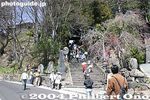
There are no buses nor taxis to where we want to go.
|
|
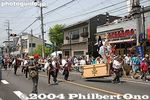
Parade of Nagamochi which are long chests. 長持
|
|

The current bridge was rebuilt in 1979 and painted a beige color.
|
|

Ohmi Railways Gokasho Station train platform.
|
|

Entrance to former home of Omi merchant Tonomura Shigeru.
|
|
|

1st floor of Takashimaya Dept. Store.
|
|

Tatsumi Turret (巽櫓)
|
|

A suspension bridge over the river.
|
|

A few bridges span the river.
|
|

Boarding time at Imazu Port. In the forefront is a song monument for Biwako Shuko no Uta.
|
|

Twenty-six design entries were submitted this year. There was no top winner, so the final design was based on the three best designs. This design features the kanji "Yorokobu" or joyfulness. 今回のテーマは「いのち」
|
|

Seta-Karahashi Bridge, the start line.
|
|

The retirement ceremony had a lot of Hawaiian touches. This was only the beginning.Hula dancers and live Hawaiian band from Hawaii.
|
|
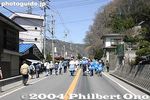
We had to walk it. This was April 10, 2004, one of the days for Shimo-sha Shrine's Yamadashi when they hauled the logs from the mountain forest.
|
|
|
|
|

In front of Gokasho Station is a map and stone monument. Gokasho is also a National Important Traditional Townscape Preservation District (重要伝統的建造物群保存地区).
|
|

Living room of former home of Omi merchant Tonomura Shigeru.
|
|
|

Exhibit of Nagahama bonsai plum trees and folding screen from Hikone, 1st floor of Takashimaya Dept. Store during the Grand Omi Fair.
|
|

Tatsumi Turret (巽櫓)
|
|

Tama River as seen from the bridge.
|
|
|

Megan and Jamie Thompson about to board the boat. トンプソン姉妹
|
|

They introduced the three best designs. 最優秀作品はなく、3点の優秀賞作品を参考に保存会が決めた。
|
|

Up to four rowing teams raced down a 250-meter straight course.
|
|

Konishiki also sings. (His company arranged the entertainment.)
|
|
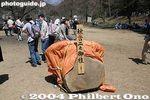
After walking for 30 min., we reached this place called Shimekake, a resting place for the logs which had been hauled from the mountains. This is Log No. 2 for Akinomiya Shrine. 注連掛
|
|
|
|
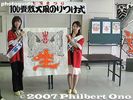
The new kite design was then announced. Called Han-jimon (判じもん), the design expresses a certain theme using word play with a pair of animals and one or two kanji characters. 八日市大凧は3年に一度図柄を変える。
|
|

Stone monument for the local Obata shonin merchants.
|
|
|
|
|

View from castleThe train station can be seen in the distance.
|
|

Tama River
|
|

Tama River, looks very inviting in summer.
|
|

Boat name "Rio Grande" operated by Biwako Kisen. Named after Shiga's sister state in Brazil. There is also the "Michigan" paddlewheel boat named after Shiga's sister state in the USA.
|
|
|
|

Musashigawa Stable wrestler wearing Aloha-print yukataFlowery pattern (plumeria) with "Musashimaru" imprinted.
|
|
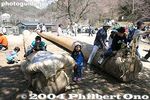
The logs will rest here for about a month until early May when they will be hauled to the shrines for the Satobiki erection.
|
|
|
|
|

The top kanji is "yorokobu" (joyfulness) which can also be read as "ki." The pair of hawks 鷹 can be read as "yo." And the bottom kanji is "sei" (living). It's "Kyosei."
|
|

Road in front of the train station.
|
|
|

Bridge ornaments
|
|

Folding screen from Hikone (National Treasure).
|
|

Castle wall and Hitsujisaru Turret (坤櫓)
|
|

Tama River, very quiet and peaceful.
|
|

Upriver as seen from the bridge.
|
|

Inside the front of the Rio Grande boat. 琵琶湖周航クルージング
|
|
|

Canon modelThis Canon ministage was surrounded by EOS 30D cameras which we could use to shoot these female models on the ministage. They let us print out a picture (A4 size) and take it home.
Compared to the 20D, the 30D has a larger LCD monitor, a higher maximum burst during continuous shooting, and spot metering. The 8 megapixels and sensor size are the same. Canon says that this is the optimum pixel count for the supporting technologies in the camera. And that the image quality does not depend solely on the megapixel count.
|
|

Musashimaru souvenirs at the Kokugikan's souvenir shop
|
|
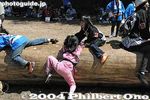
Here is where anybody can get on the logs and play.
|
|
|

Seta-no-Karahashi Bridge in autumn. 瀬田之唐橋
|
|

Old Sprite sign
|
|
|

Nihonbashi Bridge side view
|
|

PR exhibit for the Grand Omi Fair on the 8th floor.
|
|

Hitsujisaru Turret (坤櫓) is open to visitors.
|
|

Crystal clear water of Tama River
|
|
|

Open deck at the rear. The boat departed at about 11:30 am.
|
|

Higashi-Omi mayor Nakamura Koichi explains the design. "Kyosei" 共生 means to co-exist (i.e. man and nature) or to live together harmoniously. 中村功一市長
|
|

All the boats are held stationary with a rope provided from the bridge.
|
|

Canon models (EOS 30D demo)This Canon ministage was surrounded by EOS 30D cameras which we could use to shoot these female models on the ministage. They let us print out a picture (A4 size) and take it home.
|
|

Musashimaru merchandise
|
|
|
|
|
|

Bus stop and sign to the Fujii house. Gokasho has good signs showing you the way to the Omi merchant homes.
|
|

Woman's hairdressing room.
|
|

Nihonbashi Bridge monument
|
|
|

Castle tower foundation
|
|

Crystal clear water of Tama River with fall leaves.
|
|
|

We passed by various scenic spots such as Shirahige Shrine, noted for the torii gate in the lake.
|
|

The mayor and one of the kite design artists wear a sash and pose for a picture before proceeding with the Noritsuke Ceremony.
|
|
|
|

Canon model (wireless photo studio demo)Canon also had a photo studio to demonstrate a digital photo shoot with the top-of-the-line EOS D-SLR attached with a remote transmitter which transmitted the images to a computer via wireless. We saw the images appear on the TV monitor as it was transmitted to the computer. You can shoot very quickly, but the images don't transfer or appear as fast. I guess they were RAW. Here the model is showing off one of the photos which was taken and printed on the spot.
|
|

Musashimaru doll
|
|
|
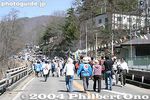
After the Shimekake, we walked further.
|
|
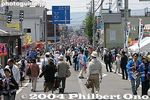
Crowded street
|
|
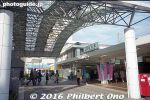
JR Yamashina Station
|
|
|

Higashikurume Station on the Seibu Ikebukuro Line. On the far left is the Fujimi Terrace lookout deck. 東久留米駅
|
|

Entrance to the bamboo grove at Takebayashi Park. 竹林公園
|
|

Cherry blossoms along the Shakujii River, near Shin-Itabashi Station on the Mita subway line.
|
|
|

Room with Hina festival dolls and entrance to the Tonomura Shigeru Literature Museum. 雛祭りの雛人形
|
|

The local neighborhood association wants this expressway to go underground.
|
|

1st floor of Takashimaya Dept. Store.
|
|

Hitsujisaru Turret (坤櫓) and castle tower foundation
|
|
|
|

Trout fishing ponds for customers in warmer months.
|
|

Shirahige Shrine 白髭神社
|
|

They used a wide brush to apply paste to the edges of a piece of kite paper.
|
|
|
|
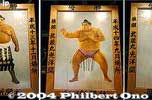
Giant painted pictures of Musashimaru decorating the arena inside. Each one commemorates a tournament victory.These giant pictures are actually black-and-white photographs taken in a photo studio and printed on large paper. Then it is hand-painted in color by a woman who has been doing it for years.
|
|
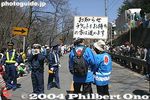
Until we were stopped here. Sign says that only people with tickets can proceed further. Yeah, we walked all this way only to be told we cannot go further. Our destination was the Ki-otoshi slope where the huge logs slide down for the Yamadashi.
|
|
|
|
|

On the west side, Higashikurume Station has a lookout deck called Fujimi Terrace to view Mt. Fuji on clear days. 富士見テラス
|
|

Higashikurume's farming homes used to each have a bamboo grove.
|
|

There are cherries on both sides of the river and a walking path on both sides.
|
|

Gokasho is a rural town.
|
|

Hina festival dolls. 雛祭りの雛人形
|
|

The double-arched bridge was built in 1911, made of granite.
|
|

Grand Omi Fair on 8th floor
|
|

Inside Hitsujisaru Turret
|
|

These photos were taken in Feb. Probably scenic in fall.
|
|

Riverside fishing ponds
|
|
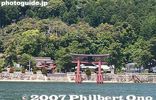
Shirahige Shrine torii as seen from the cruise boat.
|
|

They joined two sheets of kite paper together. This marked the first step in making the kite. The finished kite paper will consist of a few hundred washi paper sheets pasted together.
|
|
|

The ceremony opens with taiko drum beating on the sumo ring.
|
|

Keihan Yamashina Station is right next to JR Yamashina Station on the right.
|
|
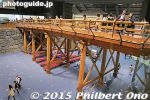
Replica of Nihonbashi Bridge at the Edo-Tokyo Museum in Ryogoku, Tokyo.
|
|
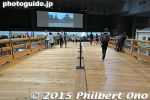
On the Nihonbashi Bridge replica at the Edo-Tokyo Museum in Ryogoku. It's not as arched as the one you see in ukiyoe prints.
|
|

About the replica of Nihonbashi Bridge at the Edo-Tokyo Museum in Ryogoku, Tokyo.
|
|

We had to wait until the Ki-otoshi at 1pm was over. That's the one we wanted to see. But the place was already too full.
|
|
|
|

Seta-no-Karahashi Bridge with the new paint job in 2012.
|
|
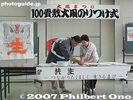
More dignitaries paste the sheets of kite paper together.
|
|

View of Fujimi-dori road from Fujimi Terrace. Unfortunately, too hazy to see Mt. Fuji. 「まろにえ富士見通り」
|
|

However, due to urban development, the bamboo groves were fast disappearing. So from 1974, the city decided to preserve this one bamboo grove.
|
|

Entrance to one walking path with a poem monument.
|
|

Another sign.
|
|

Hina festival dolls. 雛祭りの雛人形
|
|

Sky roof
|
|

Tourist corner with samurai armor of Hikone's Ii Clan.
|
|

Inside Hitsujisaru Turret
|
|

Mountain with a patch of green.
|
|

Path to Otaki Waterfalls 雄滝
|
|

Omi-Maiko with green pines on white sands. 近江舞子の「松は緑に 砂白き」
|
|
|

Sumo exhibition matches with lower division Makushita wrestlers.A retirement ceremony for an important sumo wrestler includes a variety of activities besides the actual ceremony of cutting away the topknot. It involves almost the entire Japan Sumo Association, and most wrestlers in the top three divisions (Makushita, Juryo, and Makunouchi) also appear in exhibition matches.
|
|

We had to wait until the 1pm Ki-otoshi log came out.
|
|
|

Seta-no-Karahashi Bridge
|
|

A nice short trail goes through the bamboo forest.
|
|

Higashikurume Station
|
|
|

Entrance to the former residence of Omi merchant Fujii Hikoshiro (1876-1956) (藤井 彦四郎邸)
|
|

Tonomura Shigeru Literature Museum (Bungakukan). Shigeru had a passion for writing, so he entrusted the family business to his younger brother. 外村 繁文学館
|
|

Expressway above the bridge.
|
|
|

Inside Hitsujisaru Turret
|
|

Bus stop. Notice the monkey crossing the road.
|
|

Waterwheel 水車
|
|

Omi-Maiko appears in the song.
|
|

The pasted pieces are laid to dry.
|
|

Most races were not close.
|
|

Lumix
|
|

Makushita sumo matchLower-division wrestlers wear black belts, while the upper division wrestlers wear white belts (during practice) or colored belts during official matches.
|
|
|
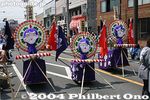
Nagamochi chest decorations
|
|

Seta-no-Karahashi Bridge over Seta River
|
|
|
|

Former residence of Omi merchant Fujii Hikoshiro (1876-1956) (藤井 彦四郎邸). Now a history museum.
|
|
| 6927 files on 28 page(s) |
1 |
 |
 |
 |
 |
|